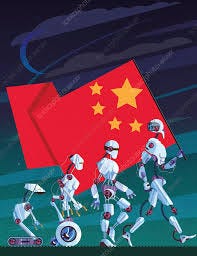The Coming Wave of AI Automation: How China’s Robotics Strategy Validates the Counter-Cyclical AI Inferencing Thesis
By Tim McDonald, Synthetic Wisdom
Automation is Not Cyclical—It’s Counter-Cyclical
China is racing ahead in industrial robotics, aggressively automating its supply chains while the U.S. lags behind in adopting similar large-scale automation strategies. A recent SemiAnalysis report, America Is Missing the New Labor Economy – Robotics Part 1, highlights how China is developing an end-to-end robotics ecosystem—one that could permanently reshape global labor markets.
While much of the Western world sees automation as a slow, linear adoption curve, the reality is far different. Automation is counter-cyclical, meaning its adoption accelerates during economic downturns, not just during boom times.
This ties directly into our thesis on AI inferencing capacity as a deflationary labor displacement force—a theory that suggests businesses will increasingly turn to AI-powered automation as a survival strategy during recessions and economic contractions.
The future of automation will not be driven by robotics alone. In the U.S., we believe AI inferencing will serve as the equivalent of China’s robotics boom—driving labor substitution in white-collar industries the way robots are replacing blue-collar workers in China’s factories.
China’s Automation Strategy: The Robotics Push
The SemiAnalysis article makes it clear: China is moving full speed ahead on robotics, while the U.S. remains cautious. Key takeaways:
China is investing in full-scale industrial automation, reducing its reliance on human labor.
Rapid iteration and economies of scale are making China’s robotics cheaper and more effective.
China controls critical supply chain components (gearboxes, motors, actuators, batteries), further solidifying its dominance.
Western economies are hesitant, still debating the ethics and trade-offs of automation rather than acting decisively.
China sees robotics as a necessity, not an optional investment. The U.S. must make a similar commitment—but with AI inferencing.
AI Inferencing: The U.S. Equivalent to China’s Robotics Strategy?
While China is automating physical labor, the U.S. has an opportunity to double down on AI inferencing and knowledge work automation.
The industries most exposed to this shift include:
Healthcare: AI-powered diagnostics, administrative automation, and patient data analysis.
Financial Services & Legal: AI-driven risk assessment, contract automation, compliance.
Retail & Customer Service: AI replacing call centers, sales assistants, and logistics coordination.
China is betting on robotics replacing workers, but the U.S. may end up betting on AI replacing decision-making and knowledge work.
Why AI Automation Surges in Economic Downturns
This brings us to the counter-cyclical nature of automation.
When the economy is strong, companies focus on growth, and labor markets remain tight. But during downturns, automation isn’t put on hold—it accelerates.
Why?
Cost-cutting becomes priority #1: Companies will look to AI and automation to replace expensive human labor.
Businesses must remain competitive: If firms don’t automate, they risk losing market share to those that do.
AI and robotics deflate labor costs: As wages stagnate or drop, the relative cost of AI-powered automation falls, making adoption even more attractive.
This is the inverse of conventional wisdom, which assumes automation investment slows during downturns. Instead, AI inferencing demand rises as companies look for efficiency gains—making AI-powered automation a counter-cyclical asset.
The U.S. Response: Will We Act or Fall Behind?
If the U.S. fails to adopt AI-powered automation aggressively, China will continue widening its lead—not just in manufacturing, but in overall labor efficiency.
What Needs to Happen?
Policy and investment shifts: The U.S. must recognize AI automation as a core industrial policy priority, just as China has done with robotics.
AI inferencing infrastructure: As we’ve argued before, AI inferencing capacity is a new unit of labor—the U.S. must scale this infrastructure rapidly.
Business adoption acceleration: Companies need to see AI-powered decision-making and automation as a necessity, not a future luxury.
China’s industrial robotics playbook provides a direct warning to Western economies: those who automate first win the future.
Final Thoughts: AI Automation is Coming Faster Than We Think
The SemiAnalysis report confirms our view: automation isn’t happening in cycles—it’s accelerating in response to economic pressures.
For the U.S., the real question is whether we will lead the next wave of AI-driven labor automation or fall behind as China cements its dominance in robotics.
The next recession won’t slow down automation—it will speed it up.
The companies and nations that recognize this shift now will be the ones that define the global economy for the next decade.

